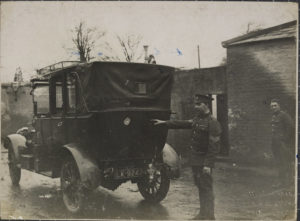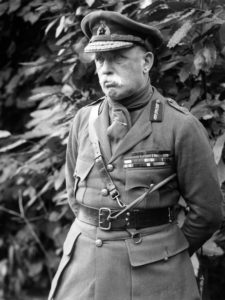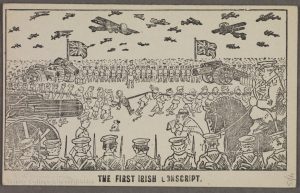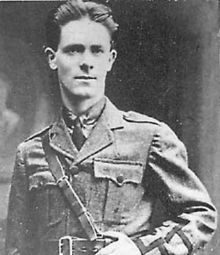Today in Irish History, 19 December 1919, The Attempted Assassination of Sir John French

One hundred years ago today, the attempt on the life of the Lord Lieutenant of Ireland. By John Dorney
On a cold December day in 1919, a group of young IRA members waited at a public house near the Ashtown gate of Dublin’s Phoenix Park.
Some were from Dublin, members of Michael Collins’ recently created ‘Squad’ or assassination unit. Others were from farther afield, like Dan Breen and Sean Treacy from Tipperary, or like Martin Savage, from Sligo.
A team of IRA men narrowly failed to kill Sir John French the Lord Lieutenant of Ireland at Ashtown, near the Phoenix Park.
They were waiting for Sir John French the Lord Lieutenant of Ireland, the most senior British official in the land. He was returning from a visit to the west of Ireland and had alighted at Ashtown train station before returning by car to his official residence, the Vice Regal Lodge, in the Phoenix Park.
The IRA men had a signaller in a tree and when French’s car approached, they tried to block the road with a farm cart. They were too late however to block the Lord Lieutenant’s car which swept through the impromptu barricade. Shot were fired and one policeman wounded but French himself emerged unscathed.
A second car, which the IRA thought contained French, in fact bore the brunt of the guerrillas’ revolver fire and grenades, but though the car was badly damaged, there were no casualties.
The third car in the convoy contained French’s military escort and the soldiers inside the vehicle returned fire, killing one of the attackers, Martin Savage. Some of the Volunteers attempted to recover his body but the Crown forces’ fire was too heavy. Savage’s body was left on the scene as the IRA party fled on bicycles back to the city.
The Irish Times, for one, expressed outrage at the attack, ‘the attempted assassination of the greatest of Irishmen’ which, it said would ‘shock Ireland’ and force Sinn Fein, victorious in the election of the previous year to reflect on whether it wanted to be associated with ‘outrage and assassination’. ‘There will now be many throughout the world ready to attribute the character of a murder society to the whole new Irish movement’. [1]
But some, even Prime Minister Lloyd George, were surprisingly unsympathetic. ‘They are bad shots’ was his only remark on hearing of the attack.[2]
Many in Ireland were even less sympathetic to hear of the escape of the Lord Lieutenant. The Irish Catholic Bishops the next day issued a statement condemning not the attack but British rule in Ireland, which they characterised as ‘rule of the sword, utterly unsuited to a civilised nation’.[3]
The attack was, in hindsight, a turning point, moving the standoff over Irish independence towards all out guerrilla war, but also, in a way, symbolising the eclipse of French and of his vision for what the country should be.
Who was Sir John French?

French was born in Kent, England in 1852, but his family seat was in Frenchpark County Roscommon. That the town bore his family name was no coincidence. They had established their seat there in the 18th century. French traced his ancestry back to medieval Anglo-Norman settlers who had become part of Ireland’s Protestant ruling class.
French saw himself as an Irishman, but his conception of that title was very different to the separatists in Sinn Fein, who wanted an Ireland completely independent of Britain. One of the ‘Sinn Feiners’, as it happened, was his sister Charlotte Despard.
She, having been widowed at a young age, converted herself from aristocrat to socialist, pacifist and Irish nationalist. But John French himself was an ardent unionist, seeing Ireland as an integral part of the United Kingdom.[4]
French enlisted at an early age in the army, serving as a cavalryman and rose through the ranks to command the British cavalry in the Boer War and the entire British Expeditionary Force in France and Belgium in 1914-15 in the First World War. He was replaced by Sir Douglas Haig as commander of British forces on the western front, amid allegations that he was not capable of waging a modern industrialised war.
Sir John French, who came from an Anglo-Irish family, commanded British forces in France and Belgium in the first two years of the Great War.
But in 1918, French found a new role as Lord Lieutenant of Ireland. The British administration in Ireland had been in flux since the Rising of 1916 and now faced a new challenge in the form of the resistance of Irish nationalists to the imposition of conscription for the Great War and the rise of radical nationalism.
Ordinarily, the most important British official in Ireland was the Chief Secretary, an MP appointed by the Prime Minister. The Lord Lieutenant, the King’s representative had become a mostly symbolic position since the mid nineteenth century, but under French it was temporarily recast as a kind of military governor of Ireland.
A Policy of repression

In order to impose conscription in Ireland, the reluctant Henry Duke, the Chief Secretary for Ireland, was by-passed, eventually to be replaced in May 1918 by Edward Shortt. In the short term however, Lloyd George appointed Sir John French, now Field Marshal, as Lord Lieutenant of Ireland, a posting he interpreted as ‘a quasi-military government’ in Ireland to impose conscription.[5]
French thought that there would be ‘disturbances’ but was confident he could overcome them. He planned to use air power, located at ‘advanced bases’ to ‘play about with either bombs or machine guns’ on those who opposed conscription.[6] Perhaps fortunately for all, he did not get his way. In the event conscription was never imposed in Ireland.
French who became Lord Lieutenant in 1918, considered Ireland ‘unfit for Home Rule’.
French, an Irish unionist by conviction, had never been very sympathetic to Irish nationalist aspirations. In 1914 he had been commander at the Curragh when some of his officers indicated they would refuse to enforce Home Rule on Ulster.
Now in the aftermath of the First World War, the British government was in theory committed to implementing Home Rule or Irish self government, which had passed into law in 1914. But French thought that, ‘every day that has passed since I became Viceroy of Ireland has proved more clearly the unfitness of Ireland for any kind of Home Rule’.[7]
He was later converted to ‘federalism’, a very limited form of Irish self-rule, partitioned between north and south, but remained virulently hostile to talk of Irish independence. This was despite the victory of Sinn Fein in the 1918 election, which it had run on a platform, not of Home Rule, but of independence.
French called the Sinn Fein movement and its military wing, the Volunteers or IRA , ‘a condition of veiled insurrection’ and embarked, in so far as the cabinet would allow him, on a policy of repression. In response to shootings of policemen in counties Tipperary and Limerick, he declared those zones ‘Special Military areas’.
He had the moderate head of the Royal Irish Constabulary, Joseph Byrne, removed and replaced with the more hardline Henry Tudor.
In July 1919 he banned Sinn Fein and the Volunteers as ‘dangerous organisations’. In September 1919, he banned the republicans’ self-declared parliament the Dáil in response to the shooting of Dublin Police detectives by Collins’ Squad.[8]
War

By November 1919, the British had banned the Dáil, Sinn Féin and a host of other nationalist organisations.
Most of the Republican political leadership was now in prison. Eamon De Valera, the President of the Republic, was in America, having escaped from Lincoln Prison.
Peaceful means of attaining Irish independence, it could now be argued, had run into a wall of repression.
This left the way open for Michael Collins and Richard Mulcahy, who had positioned themselves strategically at the head of both the Volunteers and the IRB, to launch a guerrilla war. Collins had always been convinced that such an eventuality would be necessary. ‘All ordinary peaceful methods are ended and we shall be taking the only alternative actions in a short while now’, he said in late 1919.[9]
Th attempt to kill French signaled the intent of the Republican leadership to wage war on British rule in Ireland.
And so, in December 1919, Collins ordered the assassination of Lord French, the Lord Lieutenant, on his way back to his residence in the Phoenix Park. Although French got away, the message was clear. This was not to be a state of civil disturbance or mass unarmed struggle, this was war. [10]
The Irish War of Independence escalated rapidly over the following year and a half, leaving nearly 2,000 dead until the Truce of July 11 1921.
French leave
Sir John French’s health declined in 1920 and though he held the position of Lord Lieutenant until April 1921, his central role in Irish affairs was eclipsed by new Chief Secretary Sir Hammar Greenwood.
He had wanted to retire to his estates in Ireland in 1922 but was told it was simply too dangerous for him. During the Civil War of 1922-23 his country house at Drumdoe, County Roscommon was raided by armed men who carried off much of the furniture.
He died in England in 1925.[11]
References
[1] Irish Times, 20 December 1920
[2] Richard Holmes, The Little Field Marshal, A Life of Sir john French, p.354
[3] Townsend the Republic, p.108
[4] Holmes, p.15-17
[5] Townshend The Republic, p.11
[6] Ibid.
[7] Townsend the Republic, p.99
[8] Holmes, p340-345
[9] T Ryle Dwyer, Tans, Terror and Troubles, Kerry’s Real Fighting Story, p.160
[10] Michael Hopkinson, Irish War of Independence, p.55
[11] Holmes, p.363